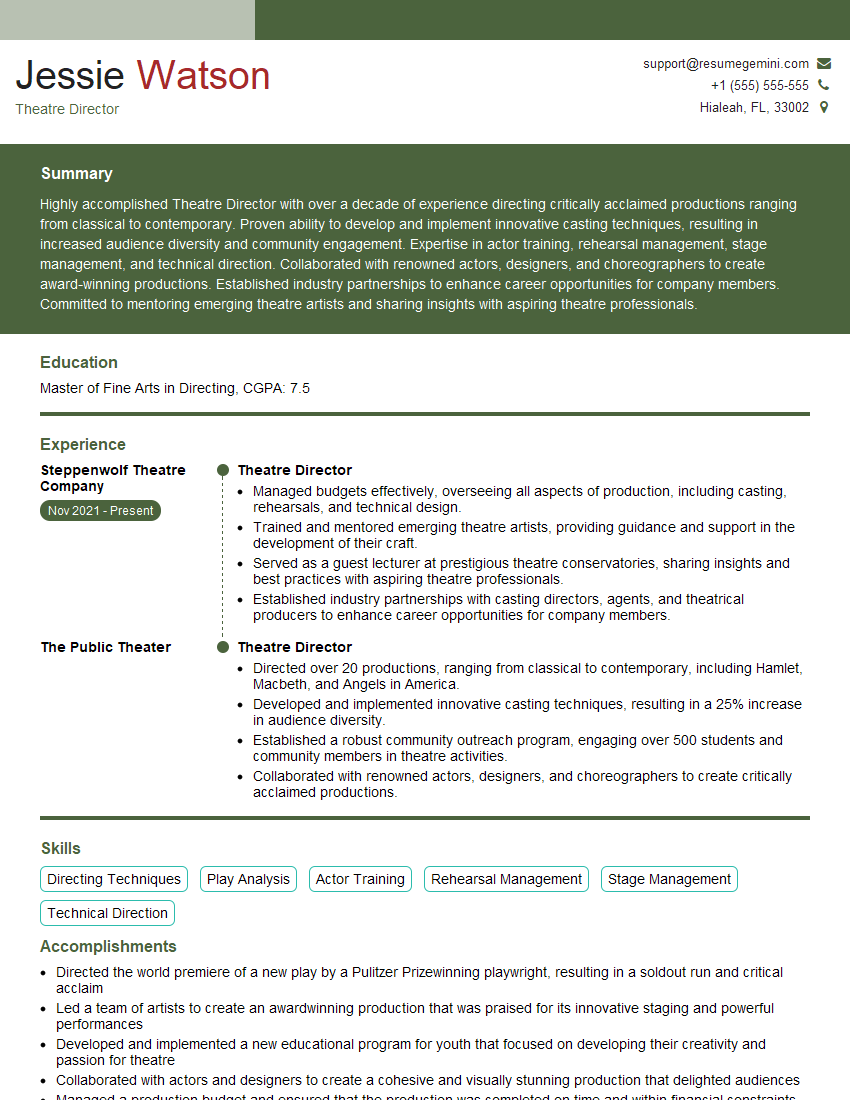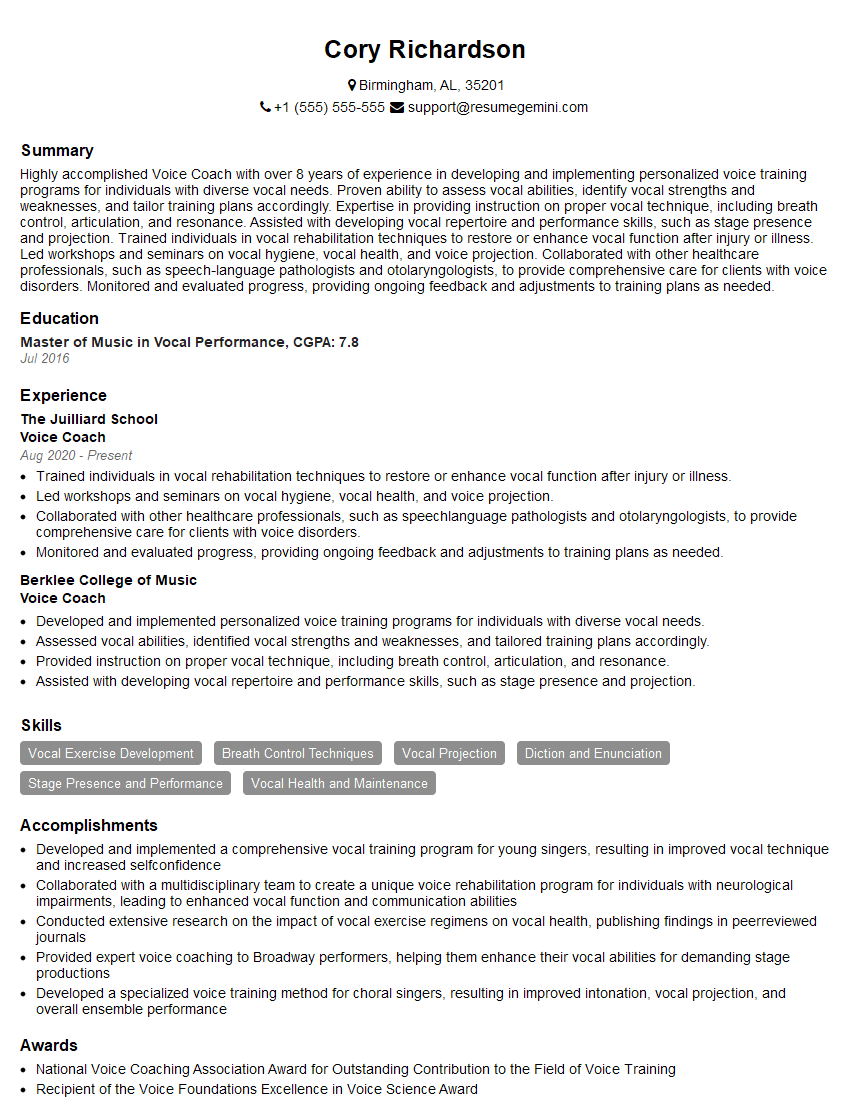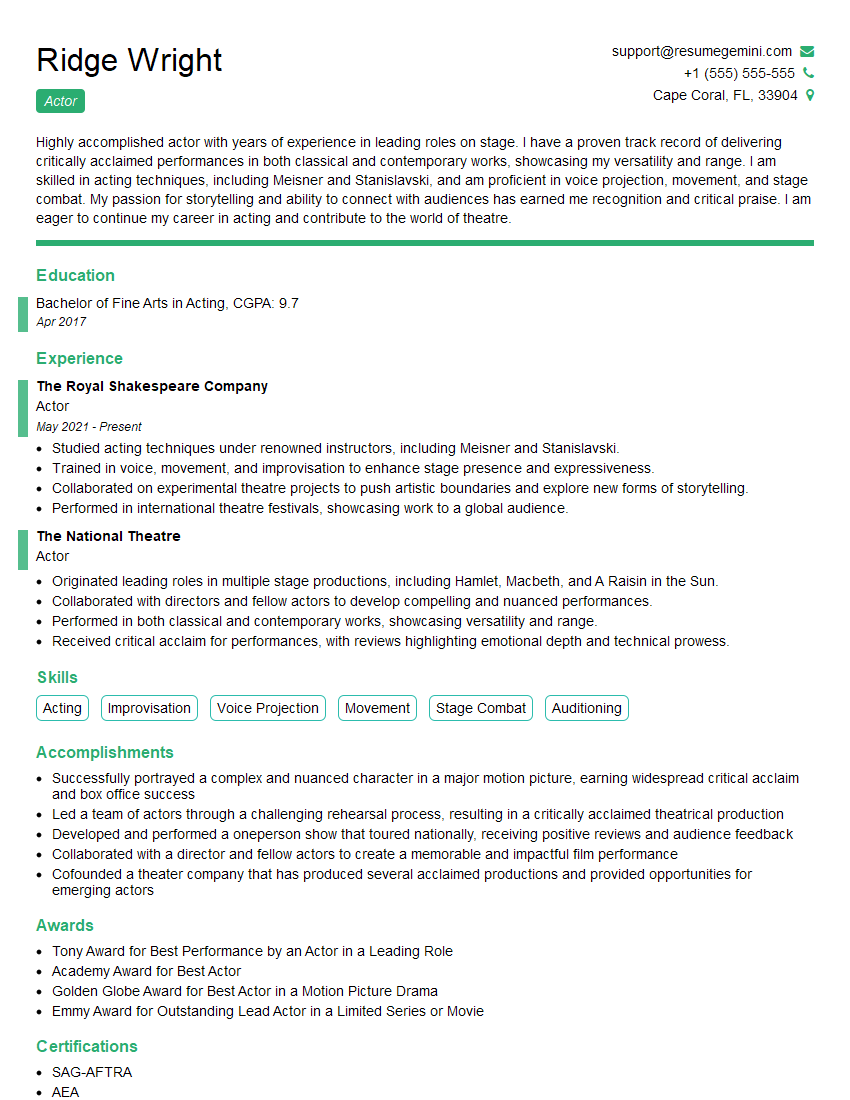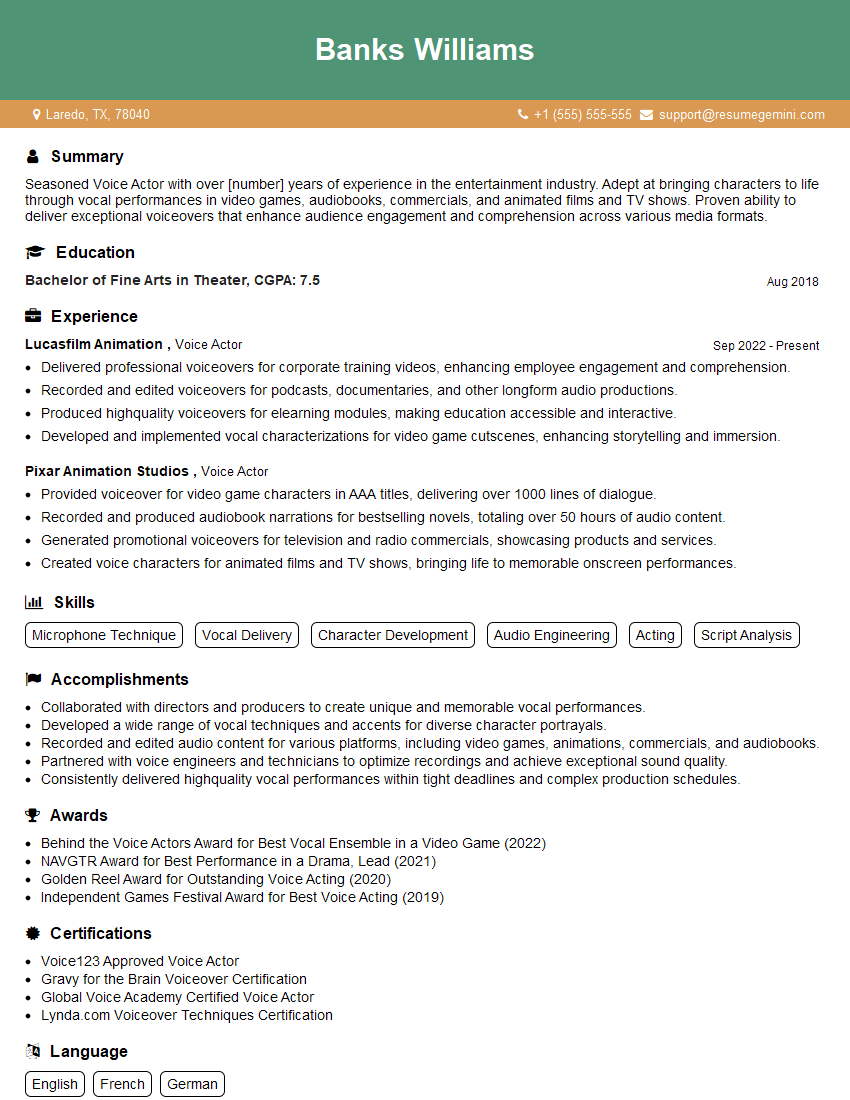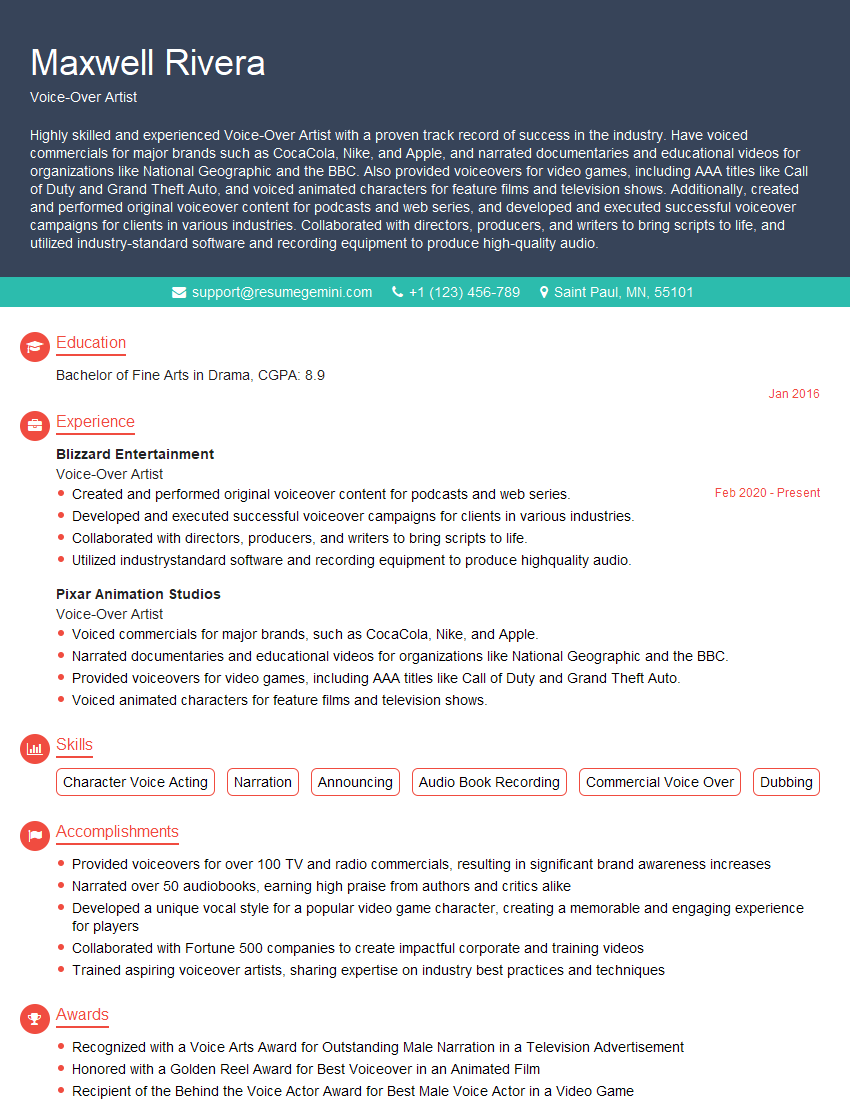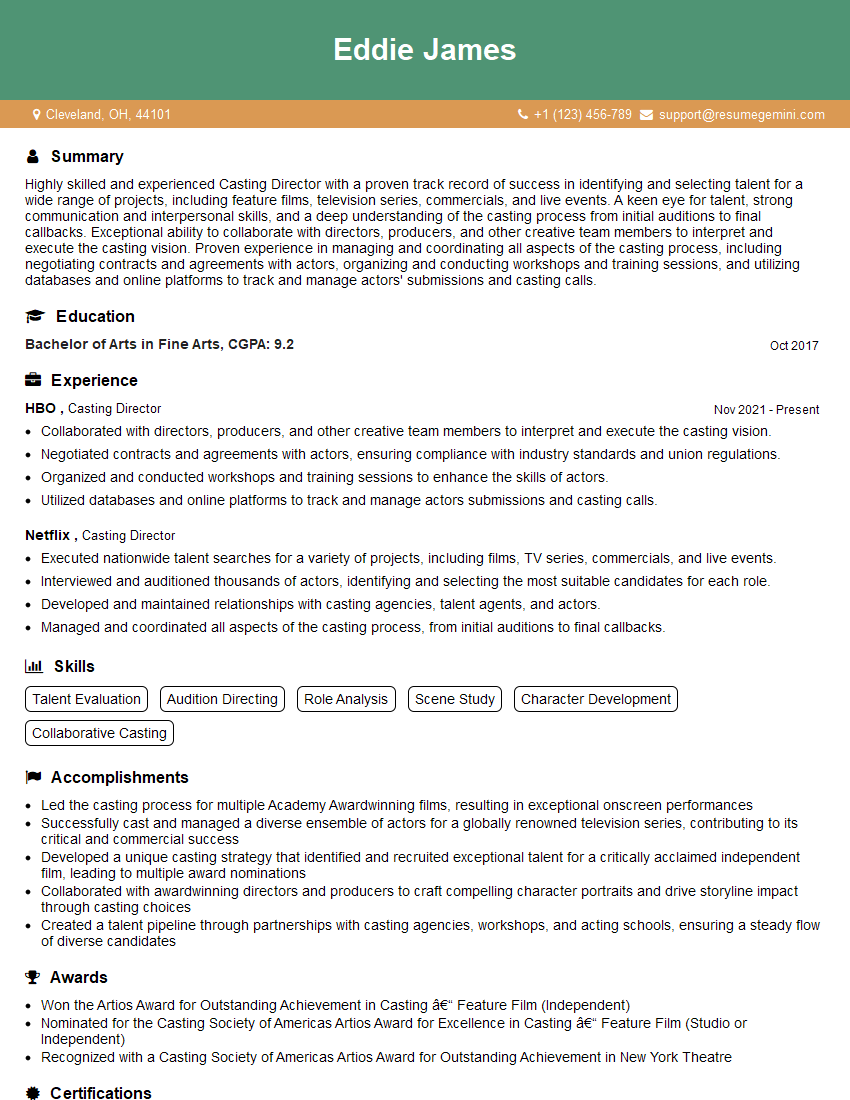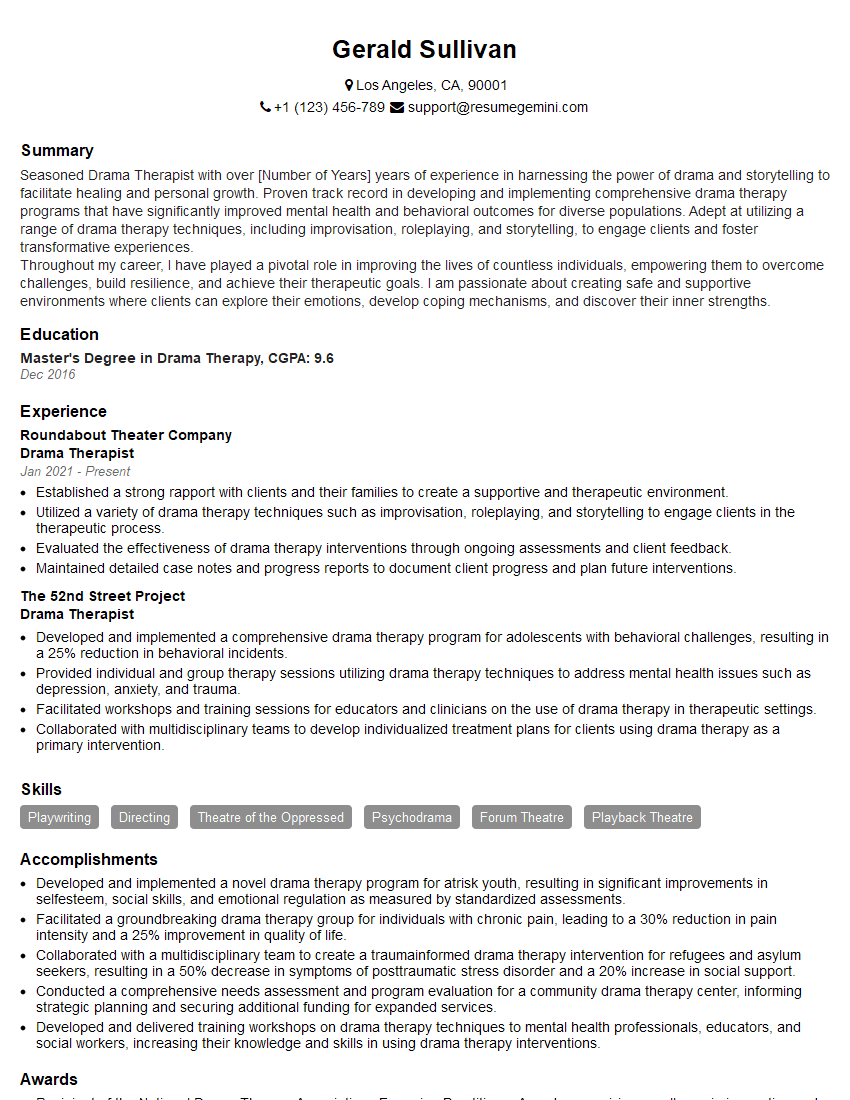Interviews are more than just a Q&A session—they’re a chance to prove your worth. This blog dives into essential Strong Understanding of Acting Techniques interview questions and expert tips to help you align your answers with what hiring managers are looking for. Start preparing to shine!
Questions Asked in Strong Understanding of Acting Techniques Interview
Q 1. Explain the difference between Stanislavski’s System and the Meisner Technique.
Stanislavski’s System and the Meisner Technique, while both aiming for truthful and believable performances, differ significantly in their approach. Stanislavski’s System, developed by Konstantin Stanislavski, focuses on deep emotional recall and the actor’s personal experiences to build a character. It emphasizes understanding the character’s objectives, backstory, and motivations through thorough analysis of the script and the actor’s own life. This often involves ’emotional preparation’ – accessing personal memories to evoke the necessary feelings.
In contrast, the Meisner Technique, developed by Sanford Meisner, prioritizes ‘living truthfully under imaginary circumstances’. It emphasizes reacting truthfully to your scene partner in the moment, focusing on the ‘here and now’ rather than relying heavily on pre-planned emotional states. The emphasis is on instinctual reactions and building relationships with other actors to create believable interactions. It’s less about digging into personal history and more about responding authentically to the stimulus of the scene partner.
Think of it this way: Stanislavski is like meticulously building a house from the foundation up, carefully planning each detail. Meisner is more like improvising a building using readily available materials, focusing on the dynamic process of construction.
Q 2. Describe your preferred acting technique and why it suits your style.
My preferred technique is a blend of Stanislavski and Meisner. I find the analytical depth of Stanislavski’s System incredibly helpful in understanding the character’s complexities, their motivations, and their arc within the story. Thorough research and script analysis helps me build a solid foundation for the character. However, I appreciate the spontaneity and immediacy of the Meisner Technique. Relying solely on pre-planned emotions can feel artificial, and responding organically to my scene partner keeps the performance fresh and engaging.
For example, in a recent role, I used Stanislavski’s approach to understand the character’s traumatic past, which informed his present-day behavior. But during rehearsals, I incorporated Meisner’s principles to react spontaneously to my scene partner’s actions, enriching the emotional truth of each interaction. This hybrid approach allows for a nuanced and believable performance that balances depth with spontaneity.
Q 3. How do you approach building a character from a script?
Building a character starts with a deep dive into the script. I analyze the character’s dialogue, actions, relationships with other characters, and their overall arc in the story. This includes understanding their objectives, their obstacles, and how they change throughout the narrative. I then look for clues about their background, their personality traits, their physicality, and their emotional landscape. This might involve creating a detailed backstory, even if it’s not explicitly stated in the script, which helps me flesh out the character’s motivations and nuances.
Beyond the script, I also consider the director’s vision for the character. Open communication is crucial. I might do research into the historical period or social context to gain a deeper understanding of the character’s world. Ultimately, building a character is an iterative process, involving research, analysis, interpretation, and collaboration with the director and other actors.
Q 4. Explain the importance of subtext in acting.
Subtext refers to the unspoken meaning, the underlying emotions, and the implicit intentions that lie beneath the surface of the dialogue. It’s the silent communication happening between characters, the emotional currents that shape their interactions. It’s what the character is really thinking or feeling, even if they aren’t explicitly saying it.
Imagine a scene where a character says, ‘Have a nice day,’ but their tone is cold and their body language is stiff. The subtext here reveals a deeper conflict or resentment, contrasting sharply with the surface-level politeness. Understanding and conveying subtext is crucial to making a performance nuanced and believable. It adds depth and complexity, and it’s often the key to captivating an audience, allowing them to interpret the hidden meanings and connect with the characters on a deeper level.
Q 5. How do you handle stage fright or nervousness before a performance?
Stage fright is a common experience for actors. My approach involves a combination of preparation, mindfulness, and self-compassion. Thorough rehearsal is key; the more familiar I am with the material, the less anxious I feel. I also practice relaxation techniques, such as deep breathing exercises and meditation, to manage my nervous energy. Before a performance, I focus on the positive aspects of the experience – the opportunity to share the story, the collaboration with my fellow actors, and the joy of performing.
Recognizing that nervousness is normal is crucial. I view it not as a sign of failure, but as a sign of engagement and passion. A healthy level of adrenaline can actually enhance my performance. I try to channel that nervous energy into my performance, transforming it into excitement and focus.
Q 6. Describe your experience with improvisation.
Improvisation is an invaluable skill for any actor. It helps develop spontaneity, quick thinking, and the ability to react truthfully in the moment. My experience with improv ranges from formal classes and workshops to informal sessions with fellow actors. I’ve found it tremendously helpful in enhancing my listening skills, my ability to build rapport with scene partners, and my overall confidence in performing.
Improvisation exercises, like character creation, scene-building, and ‘yes, and…’ exercises, train me to think on my feet, to embrace the unexpected, and to find truth and humor in the unplanned. This translates directly into my work in scripted performances, allowing me to remain flexible, inventive, and responsive even when working with established dialogue and situations.
Q 7. How do you work with a director to achieve a desired performance?
Collaboration with a director is paramount to achieving a successful performance. I see the director as a valuable partner in shaping the character and bringing the story to life. Open communication is essential. I actively listen to the director’s vision and actively ask questions about their interpretation of the script and their expectations for my portrayal of the character.
During rehearsals, I actively seek feedback and use it to refine my performance. I’m receptive to suggestions and am willing to experiment with different approaches to find the most effective way of portraying the character. The goal is a shared understanding of the character and the story, working towards a unified artistic vision. The process is a conversation, not a dictation.
Q 8. What is your process for memorizing lines?
Memorizing lines isn’t about rote learning; it’s about understanding the text and making it your own. My process begins with a thorough understanding of the script. I dissect each scene, identifying the character’s motivations, objectives, and relationships with other characters. Then, I start by reading the lines aloud repeatedly, focusing on the rhythm and meaning. I don’t just memorize the words, I internalize the emotional context. This often involves exploring subtext – what’s unspoken but implied. Next, I break down long speeches into smaller, manageable chunks, working on each section until it feels natural. I find it helpful to record myself reading the lines and then listen back to identify areas for improvement in delivery. Finally, I run lines with other actors, which is invaluable for naturalizing dialogue and strengthening the flow of the scene. This collaborative rehearsal is crucial for building a realistic conversational rhythm.
Q 9. How do you use physicality to enhance your portrayal of a character?
Physicality is the cornerstone of believable acting. It’s not just about gestures; it’s about using the body to express the character’s inner life. For instance, posture can reveal a character’s confidence or insecurity. A slumped posture might suggest defeat, while an erect posture might communicate strength. Gait is also critical; a hurried, nervous pace tells a different story than a slow, deliberate walk. I use movement to convey emotions – a trembling hand can speak volumes about fear, while clenched fists might reveal anger. I also consider the character’s physicality within the context of the story. Is the character athletic, frail, or disabled? Understanding these physical characteristics is crucial in creating a truly authentic portrayal. I work closely with movement coaches to develop specific physical vocabulary, tailored to the requirements of each role. For example, playing a boxer requires training to convincingly portray the physical demands of the sport, while a frail elderly character requires mastering a different set of movements to convey their limitations.
Q 10. How do you create believable chemistry with other actors?
Creating believable chemistry with other actors relies on genuine connection and collaboration. Before rehearsals even begin, I’ll make a point of getting to know my scene partners. This involves discussions about our characters and their relationships, allowing us to find a common understanding of the dynamics between them. During rehearsals, I actively listen to my scene partners, responding organically to their performance rather than adhering rigidly to a pre-planned approach. Improvisation within the bounds of the script is very valuable. It can lead to spontaneous and believable interactions. Trust and respect are essential. It’s important to be open and vulnerable, allowing yourself to be influenced by your scene partners’ energy and choices. This allows for a natural exchange of energy and creates a more compelling performance.
Q 11. Describe your experience with different acting styles (e.g., comedic, dramatic).
I’ve had the opportunity to work in a wide range of genres, and each demands a different approach. In comedic roles, the focus is on timing, delivery, and physical comedy. Subtlety is just as crucial as broad strokes. A well-placed pause or a slight exaggeration of a facial expression can be incredibly effective. Dramatic roles require a deeper exploration of emotional complexity. I need to access a wider range of emotions and find truthful expression for them. Often, techniques like emotional recall or sensory work are valuable in creating a believable performance. In comedic performances, I might focus on physical comedy and well-timed pauses, while in dramatic roles, I might focus on internal monologues and emotional recall to bring depth and conviction to the performance. This varied experience has made me a versatile performer, adaptable to diverse demands.
Q 12. How do you approach a role that is significantly different from your own personality?
When portraying a character significantly different from myself, the key is thorough research and a willingness to step outside of my comfort zone. I begin by deeply immersing myself in the character’s backstory, motivations, and circumstances. I might research their profession, social background, or historical context. I try to find common ground between the character and myself, even if it’s just a single shared human experience. This helps me to connect to the character on a personal level. I also employ various acting techniques, such as method acting or physical embodiment. Method acting involves stepping into the character’s shoes, and I use this technique carefully and with boundaries, avoiding fully becoming the character as to maintain my own wellbeing. Physical embodiment involves adopting the character’s physical mannerisms, posture, and movements. This helps transform my physical expression, aligning it with the character’s essence. It’s about inhabiting the character rather than imitating them.
Q 13. How do you handle constructive criticism from a director or acting coach?
Constructive criticism is invaluable for growth. I approach it as an opportunity to learn and refine my performance. I actively listen to the feedback, asking clarifying questions if necessary. I avoid becoming defensive and instead focus on understanding the director or coach’s perspective. I consider the specific points raised, reflecting on how I can adjust my performance to meet their expectations. It’s important to not take it personally; criticism is about improving the overall performance, not a personal attack on me. Often, the director’s or coach’s feedback will highlight areas I haven’t fully considered, giving me new insights. I then work on implementing the suggested changes, experimenting with different approaches until I find the most effective solution. The process is collaborative – I might discuss alternative approaches with the director, finding a solution that works best for both of us.
Q 14. Describe a time you had to adapt your performance based on audience feedback.
In a production of Hamlet, I played Horatio. During the initial performances, my portrayal felt somewhat flat and lacked the emotional depth I had envisioned. The audience’s reaction – a subdued response during my key scenes – revealed this. I received feedback suggesting my delivery was too monotone and lacked emotional connection. I analyzed the scenes, re-examining Horatio’s arc and his relationship to Hamlet. I experimented with different approaches to line delivery, incorporating more inflection and subtle emotional nuance. I also worked on refining my physicality, using gestures and posture to enhance my emotional expression. This involved creating subtle changes in my voice and body language. Subsequent performances saw a more engaged audience response, suggesting my adaptations had successfully addressed the initial shortcomings.
Q 15. How do you prepare for an audition?
Audition preparation is a multi-faceted process that goes beyond simply memorizing lines. It involves a deep dive into understanding the character, the script, and the director’s vision. My approach begins with a thorough script analysis, identifying the character’s objectives, motivations, and relationships. I then research the context of the piece, exploring the historical period, cultural setting, and any relevant themes.
Next, I work on building the character. This might involve physical exercises to embody the character’s posture and movement, or vocal exercises to match their tone and accent. I often create a backstory for my character, even if it’s not explicitly stated in the script, to give them a richer internal life. This helps inform my choices and brings authenticity to the performance. Finally, I rehearse thoroughly, focusing on clarity, intention, and emotional honesty. I also prepare a few different interpretations of the same scene to show versatility and responsiveness to directorial feedback.
For example, if auditioning for a Shakespearean role, I wouldn’t just memorize the lines, I’d delve into the iambic pentameter, understand the historical context, and research various interpretations of the character. Similarly, for a contemporary role, understanding the character’s relationship dynamics, and their position within the story’s context is paramount. This comprehensive approach ensures I’m well-prepared to showcase my skills and adaptability.
Career Expert Tips:
- Ace those interviews! Prepare effectively by reviewing the Top 50 Most Common Interview Questions on ResumeGemini.
- Navigate your job search with confidence! Explore a wide range of Career Tips on ResumeGemini. Learn about common challenges and recommendations to overcome them.
- Craft the perfect resume! Master the Art of Resume Writing with ResumeGemini’s guide. Showcase your unique qualifications and achievements effectively.
- Don’t miss out on holiday savings! Build your dream resume with ResumeGemini’s ATS optimized templates.
Q 16. What is your understanding of ’emotional recall’ and its ethical considerations?
Emotional recall is a technique where actors access past personal experiences to evoke genuine emotion in a performance. It involves consciously remembering a past event and using the associated emotions to fuel their portrayal of a character. However, it’s crucial to approach this with ethical considerations. The key is to use it responsibly and avoid reliving traumatic experiences to a degree that could be harmful.
Ethical considerations include prioritizing emotional safety. It’s essential to have a strong support system, including a therapist or acting coach, who can help manage the emotional intensity. Actors should avoid pushing themselves to extremes, and always maintain a sense of control over the process. The goal is to draw upon past emotions, not to recreate them entirely. Instead of fully reliving trauma, one might focus on the emotional qualities of that experience, like sadness, anger, or joy – then utilize those emotional qualities to inform the character’s performance. Instead of reliving a traumatic experience, an actor might utilize similar feelings drawn from less emotionally harmful memories.
Q 17. Explain the importance of vocal projection and articulation in acting.
Vocal projection and articulation are fundamental to effective acting. Without them, even the most nuanced performance can be lost on the audience. Vocal projection ensures that your voice carries clearly to the back of the theatre or filming location, making your words understandable. Articulation, the clear and precise pronunciation of words, ensures that the meaning is conveyed accurately, preventing misinterpretations. Together, they create an impactful and accessible performance.
Think about a large theatre, a massive stage and a huge audience. If the actor doesn’t project their voice, the audience won’t be able to hear, and their performance will become ineffective. Similarly, slurred words or mumbling can make it difficult to grasp the essence of what the actor is trying to convey. These two components are essential for connecting with the audience and bringing the story to life effectively. Consistent voice training and exercises to improve breath support are crucial in honing these skills.
Q 18. Describe your approach to working with accents or dialects.
My approach to working with accents and dialects is based on careful research and dedicated practice. I begin by listening extensively to native speakers, recording their speech patterns and identifying key phonetic features. I might use audio and video resources, and even interact with native speakers if possible. I then focus on mimicking the sounds, paying close attention to intonation, rhythm, and stress patterns. This is not about imitation, but rather understanding the underlying mechanics of the dialect. It is equally important to respect and avoid perpetuating harmful stereotypes.
I work on breaking down the accent into smaller, manageable components, focusing on individual sounds, word stress, and sentence rhythm. I use recordings of myself speaking the dialect to identify areas for improvement, and seek feedback from others familiar with that dialect. It’s crucial to not just ‘put on’ an accent, but to understand its cultural context and how it shapes the character. Learning a dialect isn’t merely about pronunciation; it’s about fully understanding its cultural nuances and how they shape the character’s behavior and attitudes.
Q 19. How do you maintain emotional control and prevent emotional burnout?
Maintaining emotional control and preventing burnout are essential for an actor’s wellbeing and longevity in the profession. This requires a multifaceted approach, balancing intense emotional work with self-care. I prioritize setting clear boundaries between my personal life and my acting work, avoiding the temptation to “stay in character” off-stage. This means establishing rituals for transitioning out of character after rehearsals or performances, like engaging in calming activities such as meditation, exercise, or spending time in nature.
Regular self-reflection is important to identify any patterns of emotional depletion. Therapy or coaching can be particularly helpful in developing coping mechanisms for emotionally demanding roles. Learning to differentiate between emotional engagement in a role and personal emotional investment is crucial. Maintaining a balanced lifestyle which includes a regular sleep schedule, a healthy diet, and time for hobbies and social connections allows one to recover and recharge to prevent burnout and ensure long-term well-being.
Q 20. What are some common pitfalls to avoid during a performance?
Several common pitfalls can hinder a performance. One is overacting, where the performance becomes exaggerated and unconvincing. Another is underacting, where the performance lacks energy and impact. Both extremes detract from the overall narrative. Memorization issues, where an actor struggles to recall lines, can disrupt the flow of the performance. A lack of focus, including distracting habits or insufficient connection with fellow actors, can also reduce the effectiveness of a performance. In addition, ignoring directorial input or failing to understand the character’s motivations and objectives, can lead to an ineffective, shallow presentation.
To avoid these pitfalls, thorough rehearsal is crucial. Working with a coach can help refine performances, ensuring both the technical and emotional aspects are polished. Maintaining focus during the performance requires mindfulness and discipline. Keeping an open mind and actively collaborating with the director and fellow actors are important parts of developing a strong, cohesive performance.
Q 21. How do you use your body language and gestures to convey meaning?
Body language and gestures are powerful tools for conveying meaning in acting, often communicating more than words alone. They provide a visual representation of a character’s inner world, enriching the portrayal and adding depth to the narrative. Consider posture: a slumped posture might indicate sadness or defeat, while an erect posture could show confidence or defiance. Gestures such as hand movements, facial expressions, and even subtle shifts in weight can dramatically affect how a character is perceived.
For example, a character nervously fidgeting with their hands could convey anxiety or uncertainty. A clenched jaw might suggest anger or determination. The way a character moves across a stage— their gait, pace, and physicality – all contribute to portraying their personality and emotional state. Effective use of body language relies on understanding the character’s emotional state and using physicality to express it authentically. It’s about being conscious and intentional with every movement, ensuring it aligns with the character’s personality and the narrative’s flow. Careful observation of individuals and body language practice are essential aspects of mastering this important acting technique.
Q 22. How do you maintain focus during long or complex scenes?
Maintaining focus during long or complex scenes is paramount. It’s like running a marathon – you need stamina and strategy. My approach involves several key techniques. Firstly, active listening is crucial. I fully immerse myself in the scene’s dynamics, responding genuinely to my scene partner’s actions and words, rather than anticipating my own lines. This keeps me present. Secondly, I utilize physicality; even subtle movements or adjustments can keep my body engaged and prevent mental drifting. Think of it like a conductor leading an orchestra – your body is the instrument, always engaged. Finally, I use emotional recall, connecting with the character’s emotional journey, allowing me to organically navigate the complexities of the scene.
For example, in a particularly lengthy Shakespearean scene, I’d focus intently on the rhythm and meaning of the text. The physicality of the dialogue, the subtle shifts in power dynamics between characters, keep me completely anchored in the moment. If my mind wanders, I actively redirect my attention to my breath or to a specific detail in the environment. It’s a constant process of recalibration and refocusing.
Q 23. What techniques do you use to enhance your listening skills in acting?
Active listening in acting is more than just hearing words; it’s about truly understanding the subtext, the unspoken emotions, and the intentions behind them. It’s like being a detective – you are observing, analyzing, and reacting to the clues given. I enhance my listening skills by utilizing several techniques. First, I practice unconditional focus on the speaker, both verbally and non-verbally. I am observing their body language, facial expressions, and vocal tones as much as their words. Secondly, I consciously work on reducing my internal chatter; allowing space for the other actor’s energy to fill the void prevents me from interrupting their performance. This is crucial for spontaneous and natural reactions.
In a scene with an emotionally charged exchange, for example, instead of thinking about my next line, I concentrate fully on my scene partner’s emotional state. I mirror their energy to enhance rapport and create more powerful interaction. Finally, I use improvisation exercises to build the ability to instantly respond to unpredictable circumstances. This allows me to be fully present and responsive in any given moment.
Q 24. Explain your understanding of scene work and its importance.
Scene work is the foundation of acting. It’s the process of breaking down a script into individual scenes, exploring the character’s objectives, obstacles, and relationships within the context of each scene. It’s like assembling a puzzle – each scene is a piece, but understanding its relationship to the overall picture is vital. The importance of scene work lies in its ability to help actors develop a deep understanding of their characters’ motivations, relationships, and emotional arcs. It also helps actors master their technical skills, such as pacing, timing, and subtext. Without a thorough grasp of scene work, an actor risks delivering a performance that lacks depth, consistency, and believability.
In a scene involving a conflict, for instance, careful scene work would involve identifying the characters’ individual objectives (what they want), their obstacles (what prevents them from achieving their goals), and the stakes (what’s at risk). By understanding this, actors can create a more nuanced, compelling interaction. It allows actors to avoid delivering lines as facts, rather than expressions of human desire.
Q 25. Discuss the role of collaboration in acting.
Collaboration is the lifeblood of acting. It’s not a solo sport; it’s a team effort. Effective collaboration involves a willingness to listen to others, to share ideas, and to be open to feedback. It involves actively supporting the director’s vision, while also contributing individual insights to help bring it to life. It’s like a musical ensemble – each instrument has its own part, but they work together to create harmony and produce something greater than the sum of its parts. Good collaboration fosters mutual respect and trust among all team members, resulting in a more unified and compelling performance.
A good example is working with a director to refine character choices. The director may have a specific vision, but a collaborative discussion allows the actor to suggest alternate interpretations that enrich the performance. This also applies to working with other actors; trusting your scene partner allows for genuine reactions and creates a sense of spontaneity. This shared artistic journey enhances both the individual and collective performances.
Q 26. How do you handle unexpected changes or challenges during a performance?
Unexpected changes during a performance are inevitable. The key is adaptability and resourcefulness. It’s like navigating an improvisational jam session – you need to be flexible and quick on your feet. My approach is to stay present, breathe deeply, and trust my instincts. I immediately assess the situation: is it a technical issue, a deviation by a fellow actor, or something entirely unexpected? Depending on the situation, I might employ improvisation techniques to adjust my performance, or rely on my prepared character work to respond organically to the change.
For example, a prop malfunction once forced me to improvise a significant portion of a scene. I used my understanding of the character’s emotional state to create a plausible reaction, diverting attention from the missing prop and maintaining the scene’s integrity. This involves quick thinking and a strong command of character so that the adaptation is subtle and believable to the audience.
Q 27. How do you prepare for a role in different mediums (stage, film, television)?
Preparing for a role across different mediums – stage, film, and television – requires adapting your approach to the unique demands of each. Stage acting emphasizes vocal projection, physicality, and sustained energy over a longer period. Film and television require more nuanced and subtle performances, often shot in smaller segments. My preparation always starts with a thorough understanding of the script, character development, and directorial vision, but my technical approach varies. For stage, I focus on physical stamina and vocal projection, rehearsing extensively. For film and television, I concentrate on subtle facial expressions and the precision of my movements, as the camera captures even minor details.
For example, a stage performance of Hamlet requires a powerful and resonant voice to carry across a large theater, requiring specific vocal exercises. In contrast, a film role might emphasize quiet intensity and subtle eye movements captured by a close-up shot. This calls for different physical and emotional preparations. In both cases, thorough understanding of the character’s motivations remains constant.
Q 28. Describe a time you overcame a significant challenge in a performance.
In a production of A Streetcar Named Desire, I faced a significant challenge during the climactic scene. I experienced a sudden and unexpected bout of stage fright right before my entrance. My heart was pounding, my hands were shaking. Instead of panicking, I took deep breaths, focusing on my physical sensations and using this anxiety to fuel the character’s own heightened emotional state. I channeled my nervousness into Blanche’s vulnerability and fragility. I used the physical tremors as an aspect of her fragile state, rather than allowing it to derail my performance.
The audience was completely unaware of my internal struggle. By using my anxiety as a tool to enhance the character’s emotional reality, I transformed a potentially disastrous situation into a powerful and moving performance. This experience highlighted the importance of presence, adaptability, and resourcefulness in overcoming unexpected obstacles.
Key Topics to Learn for a Strong Understanding of Acting Techniques Interview
- Method Acting: Understanding Stanislavski’s system, including emotional recall, sense memory, and the “magic if.” Consider how you’d apply these techniques to diverse roles and characters.
- Meisner Technique: Discuss the importance of truthful behavior and “living truthfully under imaginary circumstances.” Prepare examples of how you’ve utilized this approach in your practice.
- Script Analysis: Explain your process for breaking down a script, identifying character arcs, subtext, and relationships. Be ready to discuss specific examples from plays or screenplays you’ve worked on.
- Character Development: Demonstrate your ability to create believable and compelling characters, considering their backstory, motivations, and objectives. Highlight your understanding of physicality, voice work, and improvisation in character building.
- Improvisation and Scene Work: Discuss your experience with improv techniques and how they contribute to spontaneity and character development. Be prepared to discuss the collaborative nature of scene work.
- Vocal Technique and Physicality: Explain your understanding of voice projection, diction, and body language, and how these contribute to effective storytelling.
- Audition Preparation and Technique: Discuss strategies for preparing for auditions, including cold reading, creating compelling monologues, and adapting your performance to the specific requirements of the role.
Next Steps
Mastering acting techniques is crucial for career advancement in the performing arts. A strong understanding of these principles will not only enhance your performance skills but also demonstrate your dedication and professionalism to potential employers. To significantly boost your job prospects, create an ATS-friendly resume that highlights your skills and experience effectively. ResumeGemini is a trusted resource that can help you build a professional and impactful resume tailored to the specific requirements of your desired role. Examples of resumes tailored to showcasing a strong understanding of acting techniques are available through ResumeGemini to help guide you.
Explore more articles
Users Rating of Our Blogs
Share Your Experience
We value your feedback! Please rate our content and share your thoughts (optional).
What Readers Say About Our Blog
Hello,
We found issues with your domain’s email setup that may be sending your messages to spam or blocking them completely. InboxShield Mini shows you how to fix it in minutes — no tech skills required.
Scan your domain now for details: https://inboxshield-mini.com/
— Adam @ InboxShield Mini
Reply STOP to unsubscribe
Hi, are you owner of interviewgemini.com? What if I told you I could help you find extra time in your schedule, reconnect with leads you didn’t even realize you missed, and bring in more “I want to work with you” conversations, without increasing your ad spend or hiring a full-time employee?
All with a flexible, budget-friendly service that could easily pay for itself. Sounds good?
Would it be nice to jump on a quick 10-minute call so I can show you exactly how we make this work?
Best,
Hapei
Marketing Director
Hey, I know you’re the owner of interviewgemini.com. I’ll be quick.
Fundraising for your business is tough and time-consuming. We make it easier by guaranteeing two private investor meetings each month, for six months. No demos, no pitch events – just direct introductions to active investors matched to your startup.
If youR17;re raising, this could help you build real momentum. Want me to send more info?
Hi, I represent an SEO company that specialises in getting you AI citations and higher rankings on Google. I’d like to offer you a 100% free SEO audit for your website. Would you be interested?
Hi, I represent an SEO company that specialises in getting you AI citations and higher rankings on Google. I’d like to offer you a 100% free SEO audit for your website. Would you be interested?
good

